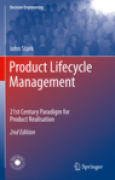
Product lifecycle management: 21st century paradigm for product realisation
Stark, John
Product Lifecycle Management (2nd edition) explains what Product Lifecycle Management (PLM) is, and why it's needed. It describes the environment in which products are developed, realised and supported, before looking at the basic components of PLM, such as the product, processes, applications, and people. Thefinal part addresses the implementation of PLM, showing the steps of a project or initiative, and typical activities. This new and expanded edition of Product Lifecycle Management is fully updated to reflect the many advances made inPLM since the release of the first edition. It includes descriptions of PLM technologies and examples of implementation projects in industry. Product Lifecycle Management will broaden the reader’s understanding of PLM, nurturing the skills needed to implement PLM successfully and to achieve world-class productperformance across the lifecycle. “A 20-year veteran of PLM, I highly recommend this book. A clear and complete overview of PLM from definition to implementation. Everything is there - reasons, resources, strategy, implementation andPLM project management.”. Achim Heilmann, Manager, Global Technical Publications, Varian Medical Systems. . “Product Lifecycle Management is an important technology for European industry. This state-of-the art book is a reference for those implementing and researching PLM.”. Dr. Erastos Filos, Head of Sector 'Intelligent Manufacturing Systems', European Commission. . “This book, written by one of the best experts in this field, is an ideal complement for PLM courses at Bachelor and Master level, as well as a well-founded reference book for practitioners.”. Prof. Dr.-Ing. Dr. h.c. Sandor Vajna, University of Magdeburg, Germany. “This comprehensive book can help drive an understanding of PLM at all levels – from CEOs to CIOs, and from professors to students – that willhelp this important industry continue to expand and thrive.”. James Heppelmann, President and Chief Executive Officer, PTC. “PLM is a mission-critical decision-making system leveraged by the world’s most innovative companies to transform their process of innovation on a continuous basis. That is a powerful value proposition in a world where the challenge is to get better products to themarket faster than ever before. That is the power of PLM.”. Tony Affuso, Chairman and CEO, Siemens PLM Software. Updates and adds to successful first edition. Gives a thorough explanationand further examples of PLM. Provides the reader with a full understanding and the skills to implement PLM within their own environment. INDICE: 1. Product Lifecycle Management. 2. Complex and Changing Environment. 3. Product Pain. 4. Emergence of PLM. 5. Opportunities and PLM. 6. Product. 7. Product Data. 8. Process. 9. PLM Applications. 10. The PDM Application. 11. People. 12. Methods. 13. Facilities and Equipment. 14. Metrics. 15. Organisation. 16. Traditional Pre-PLM Environment. 17. Change Management. 18. Of PLM Vision and Strategy. 19. Strategies. 20. Getting Executive Support. 21. Developing PLM Vision and PLM Strategy. 22. Example of a PLM Vision. 23. The CurrentSituation. 24. Current Situation Examples. 25. Maturity Model. 26. Describingthe Future Situation. 27. PLM Implementation Strategy and Plan. 28. PLM Action.
- ISBN: 978-0-85729-545-3
- Editorial: Springer London
- Encuadernacion: Cartoné
- Páginas: 838
- Fecha Publicación: 01/06/2011
- Nº Volúmenes: 1
- Idioma: Inglés
